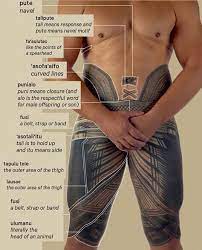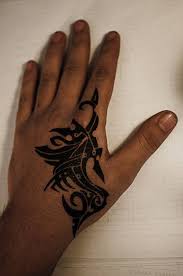
A pea is a traditional Samoan tattoo that covers the male body from the waist to the knees. Samoan tools called ‘au are used to pierce the skin and apply ink. These tools are shaped like small bone combs with sharp teeth and are attached to a turtle shell plate for strength. They allow Samoans to use ink directly onto their bodies safely.
The Pe’a
The Pe’a tattoo is a traditional male Samoan body ornament covering the torso and legs. It consists of straight lines and geometric forms representing ancestors’ migration paths from South East Asia to Polynesia. Young men undergo this critical rite of passage as they enter adulthood, marking their transition into adulthood and granting them certain privileges within the village.
Today, many young men save up until they can afford the costly ritual of getting a Pe’a tattoo. The tattoo holds meaning for them, whether representing their family and culture or carrying personal symbolism. The process of Pe’a tattooing can take weeks to complete and is performed by skilled tattoo artists known as Tufuga Ta Tatau. These artists use specialized tools made of bone, turtle shells, and wood. During the process, the person receiving the tattoo lies on mats on the floor while assistants provide support. Family members may also offer words of encouragement or sing during the process.
The Malu
Samoan women of high-ranking status traditionally receive Malu tattoos, also known as thigh tattoos. These tattoos serve as decorations and signify their standing and position within the community. Malu tattoos are an integral part of Samoan culture and tradition. They cover the thigh tissue from the top down to the knees and are applied using special tools called Tatau.
Tattooing for the Pe’a is usually done in multiple sessions. The first session typically focuses on tattooing the thighs and upper legs by a single artist. The following steps involve tattooing the aluminum, which runs from the center of each thigh up to the perineum, and the fusi, a ribbon-like piece extending down from the perineum and widening towards the hands behind the knees.
The Role of the Tufuga
Samoan tattooing is performed by master tattooists known as Tufuga Tatau. These artists use handmade tools of bone, turtle shells, and wood. Tufugas are highly respected experts in their craft and hold a prominent societal position. During the tattooing process, two assistants called ‘au to help the Tufuga by stretching the skin, wiping excess ink and blood, and providing general support.
Ta’ala, a young man undergoing the tattooing process, found mental preparation helpful in dealing with discomfort during this transitional phase from boyhood to manhood. He believed that his tattoo would represent an important milestone in his life. Ta’ala endured nine hours of tattooing daily for five days, culminating in forty-five hours. This extensive process aimed to remove any remnants of adolescence, symbolizing the transition from child to man through a pseudo-death and subsequent rebirth.
The Pain
When getting a tattoo, your body releases adrenaline and endorphins to reduce pain. This process can make the pain pleasant, similar to what experienced runners feel while running. The amount of pain you experience during a tattoo session depends on the tattoo’s placement. Some body areas have more nerve endings or thinner fat pads to cushion against needle punctures.
During lengthy tattoo sessions, a burning sensation can occur as needles repeatedly puncture the skin in one area. It may feel like something pressing against your skin, especially with larger and more intricate tattoo designs.

